Introduction
When creating emails, it’s important that every effort it made to make sure they can be read by everyone regardless of the method the reader chooses to use. Accessible emails make the information you are sending clear, readable, and engaging. This helps everyone, not just those who are disabled or who use assistive technology such as screen readers.
Many of the inclusive practices that apply to creating documents also apply to writing emails — such as using headings, alt text, meaningful hyperlinks, structured tables, sufficient colour contrast, and accessible fonts. Review the accessibility best practices below and learn how to incorporate them to make your emails accessible.
Note: These instructions focus primarily on the current desktop versions of the Microsoft 365 Office Outlook application as of January 2022.
Format
There are three formatting options in Microsoft Outlook: Plain Text, Rich Text, or HTML.
Plain text can be read by any email program and is compatible with all email systems and assistive technologies. However, plain text files can store only text characters — including numbers, symbols, and line breaks. Because of this plain text is only an acceptable option when writing simple emails.
Rich text supports text formatting, including bullets, alignment, and linked objects however, these emails can only be viewed by those using Outlook and should therefore be avoided.
HTML shows all the colors, positioning, fonts, styles, etc. you used to create it, and therefore is the best format for ensuring the creation of accessible emails. We recommend ensuring the default email setting in your Outlook is HTML. To configure or check the default format in Outlook:
- Go to File > Options.
- In the Outlook Options dialog box, select Mail.
- Select the Compose messages in this format drop-down arrow and choose the format you want to use as the default for new emails.
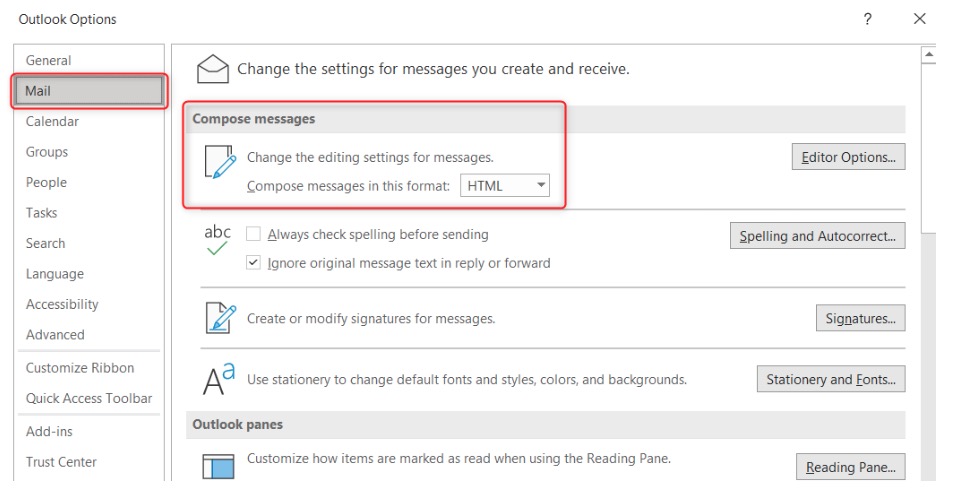
If you receive an email in one format, you can change it to another format when replying or forwarding. For example, if you receive a document in Plain Text, you can reply to it in an HTML format if you choose.
- Click Reply, Reply All, or Forward.
- In the message window, click Format Text > HTML.

Text
Font eligibility is essential for accessibility. Use a font size of 11-point or above — anything smaller than 10-point font size is generally inaccessible. Try and keep font style consistent throughout the document. It is also recommended to use sans serif fonts such as Calibri, Trebuchet, Helvetica, or OpenDyslexic. Serif fonts typically have small embellishments at the end of the font strokes and can be difficult to read at certain sizes (e.g., Times New Roman, Garamond, and Harrington).
Example of Sans Serif Fonts

Example of Serif Fonts
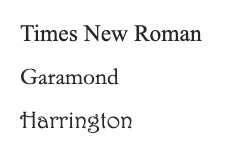
Structure
Styles and headings
Styles are sets of formatting options (like font, line spacing and alignment) that you can apply to text. They allow a screen reader to navigate around a document. They also help communicate ideas in a concrete way for students with cognitive and organizational difficulties.
Headings are a type of Style. They make it easier for all users to find relevant content in a long or complex document. Using Headings will create a real structure in your email and will make the content more usable for everyone. Heading should always be used in a hierarchical manner. For example, a level 1 Heading should always come before a level 2 Heading. Do not skip levels.
When using Headings, ensure that they all look differently to each other so that they can easily be distinguished i.e., Heading 1 looks bigger than Heading 2 etc. To access the headings in Microsoft Outlook, go to the Format Text tab.

Listed Items
When creating a list, use the Listing functions as opposed to typing numbers or dashes to denote list items. This make the content more accessible as screen readers can identify properly formatted lists and determine how many items are listed. To create a list:
- Go to Message tab.
- In the Basic Text section, click either Bullets, Numbering, or Multilevel List options.

Colour and Contrast
Do not use colour alone to convey meaning or indicate importance. It’s better to indicate important concepts by using underlined or bolded text. Screen readers can detect these font features easily which will communicate the importance to the user.
It is essential that appropriate contrast exist between text and the background. Ensure there is sufficient contrast between text and the background you are using i.e., a contrast ratio of at least 4.5:1 for normal text and 3:1 for large text. A light background and dark text or dark background and light text will typically achieve good contrast, however a Colour Contrast Analyser can be used to make sure the contrast is sufficient.
Non-text Content
Alternative Text
Alternative or Alt text must be added to any non-text content — such as an image, chart, picture, or screenshot — that conveys a meaning or adds relevance to the email. This allows screen readers to give a description of the object to the user.
To add alt text:
- Right click on the object and select Edit Alt Text.
- In the Alt Text pane, describe the object and its context. There is no need to add “image of …” before your description because the screen reader will indicate that it is an image.
- If the image offers no information or meaning, select the Mark as decorative checkbox and a screen reader will skip it.


This article by Microsoft will help you understand how to write effective Alt text: Everything you need to know to write effective alt text (microsoft.com)
Position of non-text content
To ensure that screen readers to do skip over any non-text content, the wrapping style of the object should be set as In line with text. This means the image is on its own line. From there you can position the image to the left, right, or center.
- Right click on the object and select Wrap Text.
- Select In line with text.
Tables
Tables can create challenges for people using assistive technology. To create an accessible table click Insert > Table and select the number of columns and rows you want by highlighting the gird. Do not use the Draw Table tool as this makes it difficult for the table to be read by a screen reader.
Table Structure
Use simple tables structures i.e., do not merge, or manipulate other table elements. Tables with merged cells can add considerable complications for screen reader users because it affects the reading order.
There are times when complicated tables are the best way to communicate information. When this happens, be sure to keep it as simple as possible or split the information into multiple tables. Do not use images in tables.
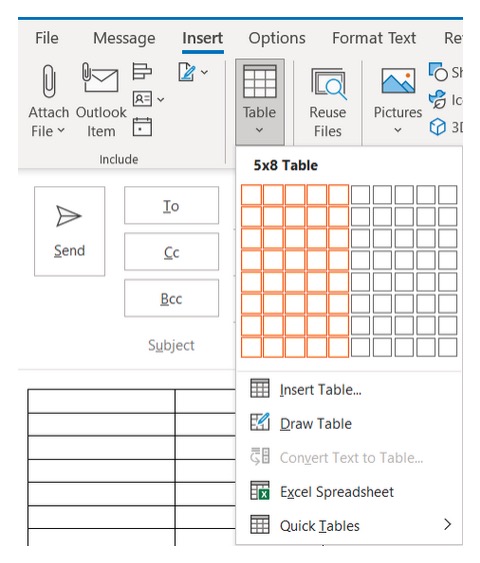
Table Headings
Tables should include a Heading Row. To add a heading row, click the table and go to the Design tab. Check the Header Row check box and choose a table style.

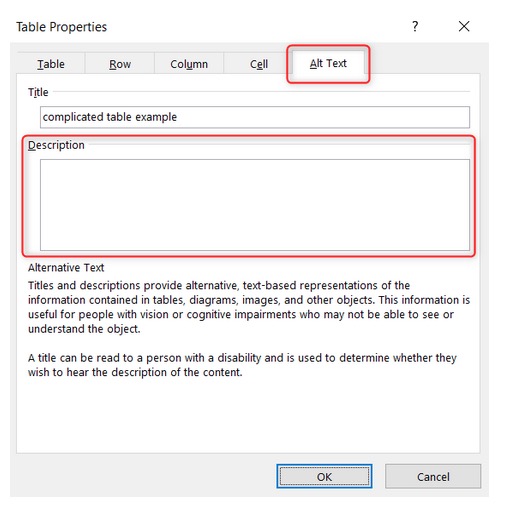
Table Alt Text
Add alternative text to your table:
- Right-click the table and then click Table Properties.
- In the Table Properties dialog box, click the Alt Text tab.
- Type a detailed description of the table, and describe the important details/message the table is conveying.
Hyperlinks
All hyperlinks should use descriptive text that accurately describes where the link leads to. Descriptive hyperlinks make it easier for the users to navigate and understand the reason for the link. To add a descriptive hyperlink:
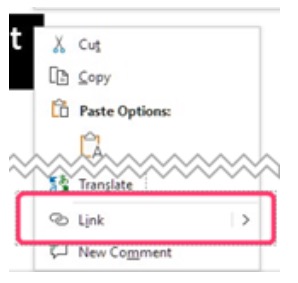
- Select the text that you want to display as a hyperlink.
- Right-click on the text and click Link (or press Ctrl+K).
- In the Insert Hyperlink box, type or paste the website URL in the Address box.
- Add the descriptive text for your hyperlink in the Text to display box.

If you have pasted a website URL directly into your email, you can edit the hyperlink by right clicking the link and choosing Edit Hyperlink. Edit the display name by adding descriptive text to the Text to display box.
Attachments
Meaningful subject line
Be sure to use a meaningful and relevant subject line for your email. This will give readers a better picture of what the email is about. It will also make it easier for both the sender and receiver to search their inbox and find the information they need.
Accessibility Check
To check the accessibility of your email, use the built in MS Outlook accessibility checker tool which can run automatically when you are writing emails. To turn on the accessibility checker select File > Options > Accessibility
The article Using the Accessibility Check in the Microsoft 365 Office Suite explains how to use this tool. For more information on using the accessibility checker while writing your email, watch the Check accessibility while you work in Outlook (Microsoft.com)-video.




